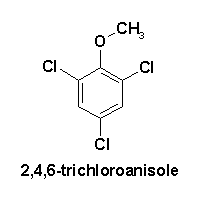Cork taint
|
|
Cork taint is a broad term referring to a set of undesirable smells or tastes found in a bottle of wine, especially spoilage that can only be detected after bottling, aging and opening. Though modern studies have shown that other factors can also be responsible for taint – including wooden barrels, storage conditions and the transportation of corks and wine – the cork is held to be the traditional scapegoat, and a wine found to be tainted on opening is said to be "corked".
The chief cause of cork taint is the presence of 2,4,6-trichloroanisole (TCA) in the wine. Corked wine containing TCA has a characteristic odor, variously described as resembling a moldy newspaper, wet dog, or damp basement. In almost all cases of corked wine the wine's native aromas are reduced significantly, and a very tainted wine is completely undrinkable (though harmless). While the human threshold for detecting TCA is measured in the single-digit parts per trillion, this can vary by several orders of magnitude depending on an individual's sensitivity. Detection is also complicated by the olfactory system's particularly quick habituation to TCA, making the smell less obvious on each subsequent sniff.
The production of TCA in wine is complex, but most results when naturally-occurring airborne fungi are presented with chlorphenol compounds, which they then convert into chloroanisole. Chlorphenols taken up by cork trees are an industrial pollutant found in many pesticides and wood preservatives, which may mean that the incidence of cork taint has risen in modern times. Chlorphenols can also be a product of the chlorine bleaching process ironically used to sterilise corks, which has led to the increasing adoption of methods such as peroxide bleaching.
TCA is responsible for the vast majority of cases of cork taint, but other less common and less known compounds that can cause different varieties include guaiacol, geosmin, 2-methylisoborneol (MIB), octen-3-ol and octen-3-one - each has its own aroma, all of them considered objectionable in wine.
The incidence of bottles with cork taint is estimated to be between 1 and 15 percent. The former figure is from the cork-industry group APCOR, which cites a study showing a 0.7-1.2% taint rate. Anecdotal evidence from wine professionals suggests that the rate may be substantially higher. Improvements in cork and winemaking methodology continue to lower the incidence, but the media attention given to cork taint has created a controversy in winemaking, with traditional cork growers on one side and powerful marketers of newer synthetic closures (such as Alcan's Stelvin® cap) on the other.
See also
External links
- Article on corked wine (http://www.winestate.com.au/magazine/article.asp?articleno=67)fr:Goût de bouchon

